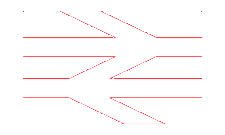

South Wales Railways
South Wales Railways in the 1930's
Looking more like a road map, this view of the south Wales valley lines dates back to the 1930's. The map shows the incredible density of lines needed to serve the coalfield and the north-south layout which took the black stuff to the main coal-exporting ports at Cardiff, Newport, Barry and Penarth.
This was the Saudi Arabia of its day with millions of tons of coal dug up every year, making fortunes for the mine owners and shippers. In 1913, over 10 million tons of coal were exported from Cardiff alone.
The map shows the Great Western Railway network in red - the thin black lines show the LMS routes into Wales. The LMS heads of the valleys line ran from Abergavenny (just off the top right of the map) into Merthyr with branches to Nine-mile point, Ebbw Vale and Abersychan. Before the 1923 railway grouping which formed the GWR as shown in the map, there were four major railway companies operating in south Wales -The Barry, Rhymney, Taff Vale and Great Western Railways.
South Wales Railways 1930's

South Wales Railways 1960's
Moving forward thirty something years and this schematic of south Wales railways gives an idea of how the network looked in the early 1960's. The Beeching cuts are still to come, the miners strike is 20 years in the future and every valley still has its heavy industry; collieries, coke works and steelworks.

The main east-west south Wales main line appears as 'section F'. Lines that are still open today are shown in red.
 |
Trains in South WalesThe decline of industry in the valleys means that almost all rail traffic with the exception of the main line is passenger. There are still freight trains running to and from Barry Docks and even the occasional rake of wagons into Aberthaw cement works but the trains running into Fords at Bridgend and Aberthaw power station have been consigned to history. These were latterly headed by the ubiquitous Class 66s but in the period covered by the second map above, the coal trains were almost always a Class 37.
Follow a Class 37 from Radyr Goods Yard To Ivor Works in Cae Harris Merthyr (external site - opens in new window) The train starts from Radyr and goes up the 'Big Hill' via Penrhos and Beddau Loop Junctions to Caerphiilly before joining the Rhymney line at Aber junction. More positively, at least up until coronavirus struck, passenger numbers have increased year-on-year with formerly 'freight only' lines such as the City line between Radyr and Leckwith Loop Jn and the Vale of Glamorgan line between Barry and Bridgend gaining new stations and opening to passenger trains.
Steam appears in small print on this brochure (left) for services on the South Wales main line.
|
 |
South Wales ExcursionsCheap rate excursions to some of the lesser known resorts on the South Wales Coast. By far the most popular day trips from the valleys to the seaside were to Porthcawl and Barry Island but some of the lesser known beaches had their share of visitors. Lavernock, Swanbridge and Sully were seaside halts on the Taff Vale Railway Cadoxton branch. This coastal line ran between Penarth and Biglis Junction just to the east of Cadoxton before falling victim to the Beeching axe in the late 1960's. After leaving Penarth, heading west, trains would pass Alberta Place halt then the site of lower Penarth Station, and the Blue Circle Cement works before arriving at Lavernock. The cement works had an extensive network of sidings and also a narrow gauge railway line which connected the works with the quarries at Cosmeston - now flooded with the resulting lakes forming a country park. Lavernock station was a good walk from the (rocky) beach but when you finally got to it, while your parents were having a drink in the Golden Hind pub, there were the world war two bunkers on the headland to explore. These were the remains of Lavernock Fort which was a searchlight and artillery post and formed part of the Bristol Channel defences. Lavernock point was also the site of Marconi's first transmission over water to Flat Holm Island. Next stop was Swanbridge for Sully beach. Another good walk along a country lane bought you to Swanbridge where, apart from another seaside pub, there was (and still is) a causeway to walk across to Sully Island.
|


The Strategic Steam Reserve - Myth or Reality?
Lines of dusty steam engines stored and ready for use after the apocalypse Find out about the hundreds of UK steam locomotives kept in storage since the sixties in case the Nuclear balloon went up. After the Soviet ICBM's had finished dropping their estimated total of 2000 Megatons TNT equivalent, a battered but uncowed Britain could emerge victorious from the fallout in the shape of Thomas the tank engine pulling a trainload of ministry of supply corned beef...


